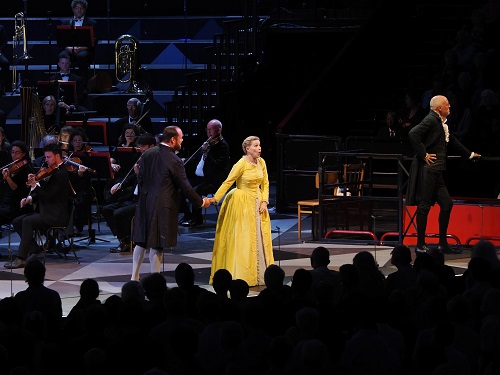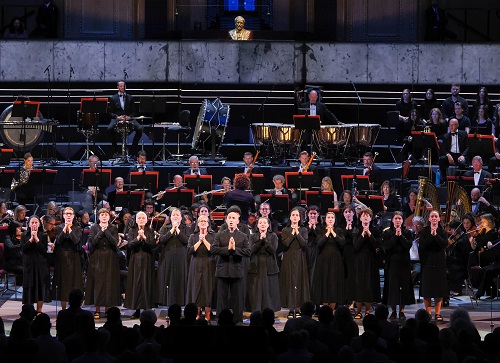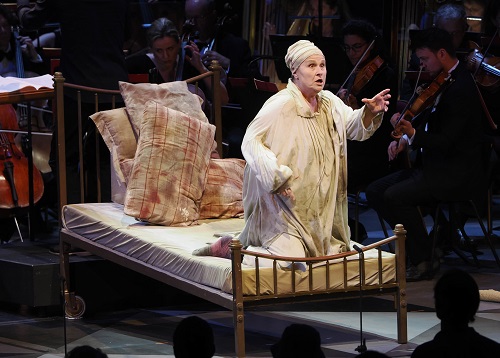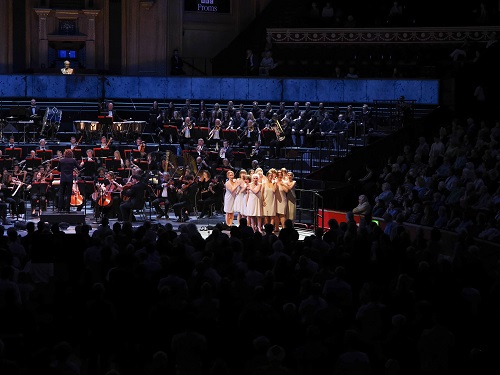Francis Poulenc’s opera Dialogues des Carmélites retells the true story of the Martyrs of Compiègne who were executed on 17th July 1794, during the French Revolution, for refusing to comply with the Civil Constitution of the Clergy – a law passed in 1790 which subordinated the Catholic Church to the revolutionary government, confiscated all Church land and banned religious orders. At the centre of Poulenc’s operatic account of this tragedy (he fashioned his own libretto after the play by George Bernanos) is the aristocratic Blanche de la Force who, fearing the mounting revolutionary fervour and driven by her vocation, takes refuge in the Carmelite convent at Compiègne. As it becomes clear that this spiritual sanctum will not offer safety, this somewhat naïve, would-be ascetic learns painful lessons about herself and humanity: “I was born in fear, I have lived in fear and I still do. All the world despises fear.” But, in the opera’s final moments, Blanche overcomes this fear, alongside her spiritual sisters, by embracing Christ’s own self-sacrificial love.
This Prom brought the Australian director Barrie Kosky’s sparse, visceral production of Carmelites, premiered to tremendous acclaim at Glyndebourne earlier this summer, to the capital. In the Sussex theatre, Katrin Lea Tag’s bleak, single set – a grey-grim room, the tapering walls of which narrowed to an opening at the rear – served as a composite location for the various tableaux, the proportions and bleakness heightening the grinding and inexorable intensity of the opera. The vast, open dimensions of the Royal Albert Hall might not seem facilitating in terms of recreating such psychological claustrophobia, but, with the ugly streaks of Tag’s walls projected onto the back panel that spans the RAH platform, the massiveness of the auditorium did bring its own impact to bear, exacerbating the sense of exposure, the vulnerability of those Compiègne nuns.

Kosky has sought to universalise the historic events. In the opening scenes, Blanche and her father, the Marquis de la Force, and brother, the Chevalier, are dressed in 18th-century costume. Blanche’s glossy primrose-yellow dress – evoking youth, happiness and love – was one of the production’s few injections of colour against the prevailing grey, black and grunge (another splash of light came in the form of the flower-bedecked cross with which the nuns adorn the Old Prioress’s grave). When, the nuns appear they don simple black tunics, and religious iconography has been largely excised. Subsequently, the revolutionary aggressors who violate the spiritual sanctity of the convent, driven by an ideological self-belief which feels all too common today, wear modern dress. And, when Mother Marie seeks Blanche, who has panicked and run away, in her now ravaged home, the protective nun and the desperate woman are dressed in skinny jeans and anoraks. A tussle over a saucepan feels not mundane or inappropriate, but all too real: an emblem of both the ordinariness and ubiquity of human frailty and fear.
The secular references feel right, too. After all, it’s not just the Church that is destroyed by revolutionary creeds and cruelty. The de la Forces’ ancestral home is disrupted by war: the Marquis is guillotined, the Chevalier exiled, the ‘Old World’ expunged. Mother Marie’s words, “to live is nothing when life is thoroughly debased”, are as true for those inside the convent walls as for those without.
Historical accounts of the Carmelites’ trial suggest that the nuns were wearing their outlawed religious habits, as their only secular clothes were being washed on the day of the trial. Kosky tops their black tunics with diverse, coloured head-dresses – scarves, beanies, hijabs – again alluding to both different faiths and to the secular. Such allusions are further broadened through direct, but unfussy, gestures. At Glyndebourne, the nuns’ hair was cut before their executions, the painful snipping sound of the scissors’ scythes anticipating a forthcoming knife. At the RAH, placards were hung around their necks. Tunics and shoes were removed; the nuns would go to the scaffold in white underdresses. A commissary callously through their rings and rosaries into a carrier bag.

If the staging (directed by Donna Stirrup) at the RAH and props were minimal – just a few chairs, a bed, carried on and off by the ensemble of nuns – then the choreography was striking, emphasising as it did the strength of each nun’s individual faith but, more than that, the intense force of their collective belief. Ranged in a line across the stage, standing when at prayer, lying prostrate in devoted commitment to their God, seated awaiting the outcome of their trial, their ritual calm was compelling. Even a panic-attack by a nun suddenly recognising the reality of death and the hideous brutality to come was soothed by the collective spirituality. And, one was reminded that the convent was both an enclosure and a liberation, freeing the sisters from patriarchal domination and abuse.
Inevitably, not all of Kosky’s coups de théâtre could be reproduced at the RAH, but the incursion of hoodied revolutionary thugs – Theodore Platt’s vicious Jailer, the two Commissaries (Gavan Ring and Michael Ronan) – into the convent was still threatening and unnerving. But, as the Commissaries violently pulled the women from their protective circle and threw them to the ground, so they rose and regrouped, rearranging themselves to allow each and every woman within their embrace. A terrifying violence may have been all around – the Glyndebourne Chorus stamped their feet to the timpani’s roll, spitting and screaming, baying and beating the air (fist-waving mobs belong to every era) – but the women’s circle of spirituality and sisterhood was a graceful and comforting visual embodiment of the conviction expressed by Sister Constance: “We die not for ourselves alone, but for one another, or sometimes even instead of each other.” It complemented other small gestures of humanity – a hand extended, a shoulder touched. And, it anticipated the final scene in which the nuns huddled close together on the right of the stage to sing the Salve regina, their numbers gradually dwindling as they departed, identifying with Christ’s own self-sacrificial martyrdom, to accept their tragic destiny.
Returning to the role she sang at the Royal Opera House in 2014, as Blanche, Sally Matthews presented a searing portrait of psychological fragmentation. In 2014 I wrote that her Blanche was rather tremulous in the middle range’ though ‘Matthews produced a bright clarity at the top when Blanche succumbs to her fears’. On this occasion I was incredibly impressed by her eloquence and radiance through which she communicated Blanche’s aristocratic naivety and her rational declarations of faith, and by the intensity – which distilled that bright radiance into fierceness and power – which charted her growing hysteria.

Matthew’s psychological realism was more than matched by Karen Cargill as Mother Marie of the Incarnation. Cargill had intense dramatic and vocal presence, and the imposing breadth and depth of her mezzo conveyed every atom of fierce maternal love and defiance. Negotiating the high, angular lines with absolute assurance, Cargill made us feel the emotive power of Mother Marie’s expressions of spiritual commitment, the high standards she inspired as she pressed her sisters to take the vow of martyrdom. This only made her own guilt, as a survivor, more poignant.
Katarina Dalayman was both utterly compelling and painful to watch, as the Old Prioress, Madame de Croissy, whose delirious death-scene was unnerving, her body twisting in the torment of a terrible doubt, her voice a wail of wrenching pain. She collapsed on top of Blanche, deepening the latter’s own psychological fault-lines. In contrast, as the New Prioress, Madame Lidonie, Golda Schultz’s tonal beauty and wonderful legato brought consoling warmth and reassurance. The presence of mind and reassuring optimism embodied by the South African soprano’s soaring gloriousness presented an enervating dramatic contrast to Cargill’s ferocity and Dalayman’s despair.

Florie Valiquette’s Sister Constance was dramatically engaging: independent of thought and passionate, hers was the dissenting vote in the secret ballot. But, rescinding her wish to live and joining sisters in martyrdom, her inner grace was evident too, in her unwaveringly crystalline tone. Despite her passion, she was true to her name.
Bass-baritone Paul Gay’s Marquis de la Force was intense and fraught: he had fears of his own. And, tenor Valentin Thill’s Chevalier was surprisingly dominating and paternal – sometimes surprisingly angry and forceful – though in his farewell encounter with his sister he did soften his tone as the line rose to the top. Vincent Oronneau was a sympathetic Father Confessor, especially when delivering a final mass for the sisters, although his tenor didn’t always project clearly in the RAH.
Robin Ticciati led the London Philharmonic Orchestra in a superlative performance which somehow assimilated disturbing contrasts of tenderness – all gossamer strings and woodwind delicacies – and violence, the ripping roar of brass and timpani. There is little direct dramatic action in the opening two acts; instead there are ‘dialogues’ – about the theological transferability of deaths; the impossibility of divine intervention to provide peace – the latter comes, so Mother Marie says, from self-mastery. But, Ticciati kept those ostinato and rocking minor thirds moving inevitably forwards, sudden interjections of the double basses’ pizzicato tread providing startling movements of vigour. He created one enormous arc which encompassed both pauses and pushes. The whole was absolutely taut but it accommodated moments of ravishing beauty, and stillness too, at the ends of scenes, the instrumental interludes resuming the momentum with an inescapability which increasingly drew one into the unfolding tableau.

Ticciati’s loving care communicated the score’s spirituality but also its sensuality. Don’t all martyrdoms fuse these two extremes? One is minded that Poulenc’s Catholicism and homosexuality may have existed in an uneasy balance. The shocking violence of the final scene – one imagines that the stereophonic whiplash slice of the guillotine was even more viscerally overwhelming at Glyndebourne – concluded in a final chord which was firm and resolute. It offered the listener a chance to step back from the horror – a release.
Claire Seymour
Blanche de la Force – Sally Matthews, Madame de Croissy (Old Prioress) – Katarina Dalayman, Madame Lidoine (New Prioress) – Golda Schultz, Mother Marie of the Incarnation – Karen Cargill, Sister Constance of St Denis – Florie Valiquette, Mother Jeanne of the Child Jesus – Fiona Kimm, Marquis de la Force – Paul Gay, Chevalier de la Force – Valentin Thill, Father Confessor – Vincent Ordonneau, Jailer – Theodore Platt, Thierry, a footman – Jamie Woollard, M. Javelinot, a physician – Matthew Nuttall, Sister Mathilde – Jade Moffat, First Commissary – Gavan Ring, Second Commissary – Michael Ronan, Officer – Michael Lafferty, Glyndebourne Festival Opera, London Philharmonic Orchestra, Robin Ticciati (conductor)
Royal Albert Hall, South Kensington, London; Monday 7th August 2023.